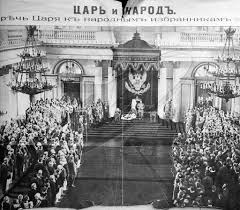
In most countries, having different branches of government to spread out the power is seen as essential tenant of government. Most, not all… In fact, Imperial Russia didn’t have a parliament until 1906, making it the only European power without one. Before 1906, the Tsar, in this case, Nicholas II held all power in making key decisions on matters of state. It wasn’t until The Crisis of 1905, where the Russians were defeated by Japan, and the subsequent slaughter known as Bloody Sunday occurred that the tide of change began to shift.
The events of 22 January 1905 signaled the start of widespread revolts across the country where the peasants seized land and the working laborers went on strike. Those events, in turn, led to railway stoppage across the nation, effectively paralyzing the entire country. In August of 1905, Nicholas II directed Prime Minister Sergei Witte to draft The October Manifesto which would become the basis for the 1st Russian Constitution a year later.
This document granted the people civil liberties but also established the Duma or Russian Parliment which comes from the Russian verb dumat’ – to think. Between 1906 and 1917 when the empire fell, the Duma convened a total of four times. Overall, the four dumas brought about mixed results ranging from land reform which helped modernize the country to Russification which was a policy that sought to “Russianize” other territories and peoples and was generally seen as a negative. Perhaps the greatest failure of the dumas was its inability to democratize Russia which would lead to the 1917 Revolution and the establishment of The Soviet Union.
As is often the case with a revolution, one small event festered and grew until it eventually boiled over with the spillage of blood and in turn, a demand for rights.
“You cannot buy the revolution. You cannot make the revolution. You can only be the revolution. It is in your spirit, or it is nowhere.” -Ursula K. Le Guin
“Our strategy should be not only to confront empire, but to lay siege to it. To deprive it of oxygen. To shame it. To mock it. With our art, our music, our literature, our stubbornness, our joy, our brilliance, our sheer relentlessness – and our ability to tell our own stories. Stories that are different from the ones we’re being brainwashed to believe.” – Arundhati Roy

Works Cited
- http://russiapedia.rt.com/of-russian-origin/russian-imperial-duma/
- http://search.proquest.com.ezproxy.lib.vt.edu/hnpnewyorktimes/docview/96778920/D2514F0B7F84CA9PQ/8?accountid=14826
- Freeze, Gregory. Russia A History. New York: Oxford University Press, 2009.
- http://romanovrussia.com/antique/LargeNIIphoto/
- http://www.goodreads.com/quotes/tag/revolution
- Header Image: http://www.picswalls.com/pic/russia-wallpapers/

Great job with the quotes – they were a really nice addition to the article! You should check out Michael Annan’s post. He wrote about the same topic but focused on the civil liberties aspect of the 1905 Revolution a little more. Great job!
LikeLike
I like how you clearly outline the events before, during, and after the revolution of 1905. I think you explained the October Manifesto really well, and the quotes really tied your post together in the end!
LikeLike
I agree with everyone above me and the use of your quotes! It tied your blog together really well and made it that much more interesting to read! The October Manifesto was definitely a game changer for Russian politics and it gave a more democratic feel for citizens. Tying this political reform into what is happening in our own country right now, do you think there needs to be another political reform in order to gain civil liberties more than what we as citizens already have? Just something interesting to think about! Good job!
LikeLike
In my opinion, the October Manifesto was a brilliant political move on the part of the Tsar. By establishing the Duma and giving the people a few rights, he was able to split the revolutionaries and maintain his power for just a bit longer. I feel like the Tsar probably kept a tight reign on the Duma during these early years and that might excuse their ineffectiveness. You did great research and the quotes really helped tie the post together.
LikeLike
Thanks for addressing the challenges facing the Duma and introducing us to it’s origins. The NYT article you use comes from a critical period, so good job finding that! On an unrelated note, the image you’re using in your header is gorgeous. Where is it from?
LikeLike
Thank you Dr. Nelson. A Russian friend of mine directed me to this website which she uses a lot herself after I spent over an hour looking for a header image. I rotate my headers frequently as you’ll notice to take advantage of all the beautiful pictures on here.
http://www.picswalls.com/pic/russia-wallpapers/
LikeLike
Great explanation of the events surrounding the 1905 Revolution.The revolutions that took place in Russia (not just the 1905 one) also made a great impression on future Soviet/Post-Communist leaders in the soviet-bloc states after World War II. Revolutions that came from bottom-up movements started by activists, unions, and political parties not within government were popular later in the 20th century. Old revolutionary habits die hard eh?
LikeLike